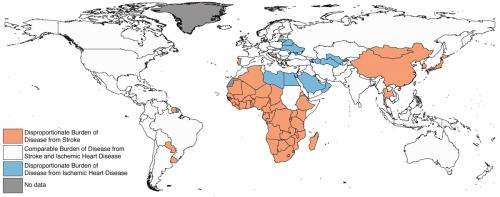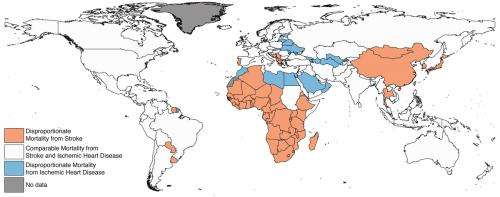Heart disease and stroke tied to national income

(Medical Xpress) -- An analysis of heart disease and stroke statistics collected in 192 countries by the World Health Organization (WHO) shows that the relative burden of the two diseases varies widely from country to country and is closely linked to national income, according to researchers at the University of California, San Francisco (UCSF).
Reporting this week in the journal Circulation, the UCSF scientists found that developing countries tend to suffer more death and disability by stroke than heart disease – opposite the situation in the United States and other countries with higher national incomes.
This observation may help health officials design interventions that best fit the needs of developing countries.
“In general, heart disease is still the number one cause of death worldwide, but there is quite a lot of variation across the globe,” said Anthony S. Kim, MD, MAS, assistant professor of neurology at UCSF who conducted the study with S. Claiborne Johnston, MD, PhD, professor of neurology and associate vice chancellor of research at UCSF.
The research highlighted the wide variation in the mortality rate for stroke, for instance, which ranged from a worldwide low of 25 deaths per 100,000 in the island nation of Seychelles to a high of 249 deaths per 100,000 in Kyrgyzstan – a rate nearly 10 times greater. In the United States, there are 45 deaths per 100,000 people due to stroke.
Two of the Leading Causes of Death
Heart disease and stroke are two diseases separated by a common pathology. Both are caused by reduced or restricted blood flow to vital organs, and the two diseases share many of the same common risk factors, such as hypertension, diabetes, high cholesterol, obesity, physical inactivity and smoking.
But because they affect very different tissues – the heart and the brain – the two diseases diverge in terms of symptoms, approaches to critical care, follow-up treatment and the duration and cost of recovery. Awareness of these differences was what motivated the study.
“There was a striking association with national income,” Kim said.
In the United States, for instance, heart disease is the number one killer and stroke the number four, according to the Centers for Disease Control and Prevention. According to the WHO data, the same is true throughout the Middle East, most of North America, Australia and much of Western Europe.

In many developing countries, the opposite is true. Stroke claims more lives and is associated with greater disease burdens in China and throughout many parts of Africa, Asia and South America. In all, nearly 40 percent of all nations have a greater burden of stroke compared to heart disease.
“This is significant,” said Kim, “because knowing that the burden of stroke is higher in some countries focuses attention on developing a better understanding of the reasons for this pattern of disease and may help public health officials to prioritize resources appropriately.”
The article, “Global Variation in the Relative Burden of Stroke and Ischemic Heart Disease” by Anthony S. Kim, and S. Claiborne Johnston was published by the journal Circulation on July 5, 2011.
UCSF is a leading university dedicated to promoting health worldwide through advanced biomedical research, graduate-level education in the life sciences and health professions, and excellence in patient care.














